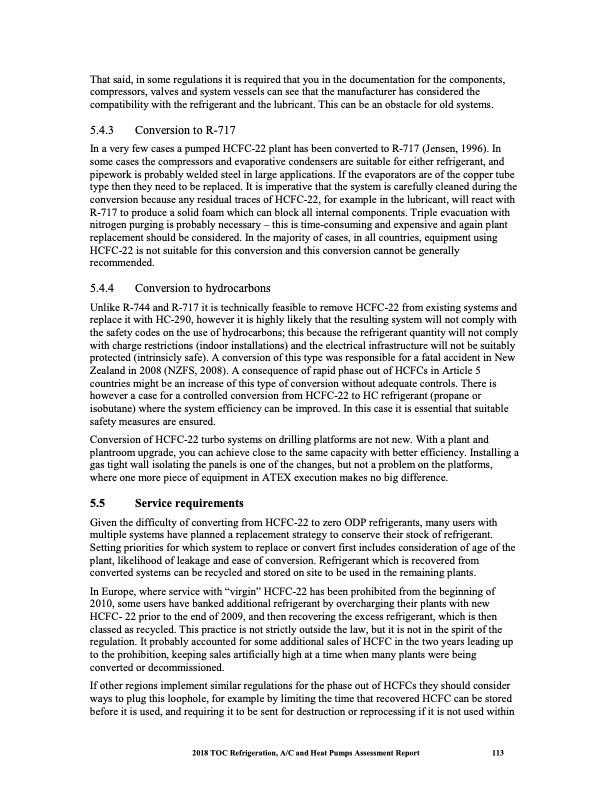
PDF Publication Title:
Text from PDF Page: 126
That said, in some regulations it is required that you in the documentation for the components, compressors, valves and system vessels can see that the manufacturer has considered the compatibility with the refrigerant and the lubricant. This can be an obstacle for old systems. 5.4.3 Conversion to R-717 In a very few cases a pumped HCFC-22 plant has been converted to R-717 (Jensen, 1996). In some cases the compressors and evaporative condensers are suitable for either refrigerant, and pipework is probably welded steel in large applications. If the evaporators are of the copper tube type then they need to be replaced. It is imperative that the system is carefully cleaned during the conversion because any residual traces of HCFC-22, for example in the lubricant, will react with R-717 to produce a solid foam which can block all internal components. Triple evacuation with nitrogen purging is probably necessary – this is time-consuming and expensive and again plant replacement should be considered. In the majority of cases, in all countries, equipment using HCFC-22 is not suitable for this conversion and this conversion cannot be generally recommended. 5.4.4 Conversion to hydrocarbons Unlike R-744 and R-717 it is technically feasible to remove HCFC-22 from existing systems and replace it with HC-290, however it is highly likely that the resulting system will not comply with the safety codes on the use of hydrocarbons; this because the refrigerant quantity will not comply with charge restrictions (indoor installations) and the electrical infrastructure will not be suitably protected (intrinsicly safe). A conversion of this type was responsible for a fatal accident in New Zealand in 2008 (NZFS, 2008). A consequence of rapid phase out of HCFCs in Article 5 countries might be an increase of this type of conversion without adequate controls. There is however a case for a controlled conversion from HCFC-22 to HC refrigerant (propane or isobutane) where the system efficiency can be improved. In this case it is essential that suitable safety measures are ensured. Conversion of HCFC-22 turbo systems on drilling platforms are not new. With a plant and plantroom upgrade, you can achieve close to the same capacity with better efficiency. Installing a gas tight wall isolating the panels is one of the changes, but not a problem on the platforms, where one more piece of equipment in ATEX execution makes no big difference. 5.5 Service requirements Given the difficulty of converting from HCFC-22 to zero ODP refrigerants, many users with multiple systems have planned a replacement strategy to conserve their stock of refrigerant. Setting priorities for which system to replace or convert first includes consideration of age of the plant, likelihood of leakage and ease of conversion. Refrigerant which is recovered from converted systems can be recycled and stored on site to be used in the remaining plants. In Europe, where service with “virgin” HCFC-22 has been prohibited from the beginning of 2010, some users have banked additional refrigerant by overcharging their plants with new HCFC- 22 prior to the end of 2009, and then recovering the excess refrigerant, which is then classed as recycled. This practice is not strictly outside the law, but it is not in the spirit of the regulation. It probably accounted for some additional sales of HCFC in the two years leading up to the prohibition, keeping sales artificially high at a time when many plants were being converted or decommissioned. If other regions implement similar regulations for the phase out of HCFCs they should consider ways to plug this loophole, for example by limiting the time that recovered HCFC can be stored before it is used, and requiring it to be sent for destruction or reprocessing if it is not used within 2018 TOC Refrigeration, A/C and Heat Pumps Assessment Report 113PDF Image | Heat Pumps Technical Options

PDF Search Title:
Heat Pumps Technical OptionsOriginal File Name Searched:
RTOC-assessment-report-2018_0.pdfDIY PDF Search: Google It | Yahoo | Bing
CO2 Organic Rankine Cycle Experimenter Platform The supercritical CO2 phase change system is both a heat pump and organic rankine cycle which can be used for those purposes and as a supercritical extractor for advanced subcritical and supercritical extraction technology. Uses include producing nanoparticles, precious metal CO2 extraction, lithium battery recycling, and other applications... More Info
Heat Pumps CO2 ORC Heat Pump System Platform More Info
| CONTACT TEL: 608-238-6001 Email: greg@infinityturbine.com | RSS | AMP |